Investigation of α-Glucosidase Inhibitory Metabolites from Tetracera scandens Leaves by GC–MS Metabolite Profiling and Docking Studies
Abstract
1. Introduction
2. Materials and Methods
2.1. Materials
2.2. Plant Material
2.3. Sample Preparation
2.4. Assay of α-Glucosidase Inhibitory Activity
2.5. Gas Chromatography–Mass Spectrometry (GC–MS) Analysis
2.5.1. Derivatization Procedure
2.5.2. GC–MS Analysis Conditions
2.6. Data Preprocessing and Statistical Analysis
2.7. Molecular Docking
3. Results and Discussion
3.1. Extraction Yield and α-Glucosidase Inhibitory Activity
3.2. Multivariate Data Analysis
3.3. Putative α-Glucosidase Inhibitory Metabolites
4. Conclusions
Supplementary Materials
Author Contributions
Funding
Acknowledgments
Conflicts of Interest
References
- Bell, M.; Blais, J.M. “-Omics” workflow for paleolimnological and geological archives: A review. Sci. Total Environ. 2019, 672, 438–455. [Google Scholar] [CrossRef] [PubMed]
- Yuliana, N.D.; Khatib, A.; Choi, Y.H.; Verpoorte, R. Metabolomics for bioactivity assessment of natural products. Phyther. Res. 2011, 25, 157–169. [Google Scholar] [CrossRef] [PubMed]
- Tebani, A.; Afonso, C.; Marret, S.; Bekri, S. Omics-based strategies in precision medicine: Toward a paradigm shift in inborn errors of metabolism investigations. Int. J. Mol. Sci. 2016, 17, 1555. [Google Scholar] [CrossRef] [PubMed]
- Sharif, K.M.; Rahman, M.M.; Azmir, J.; Khatib, A.; Hadijah, S.; Mohamed, A.; Sahena, F.; Zaidul, I.S.M. Orthogonal partial least squares model for rapid prediction of antioxidant activity of Pereskia bleo by Fourier transform infrared spectroscopy. Anal. Lett. 2014, 47, 2061–2071. [Google Scholar] [CrossRef]
- Murugesu, S.; Ibrahim, Z.; Ahmed, Q.-U.; Nik Yusoff, N.-I.; Uzir, B.-F.; Perumal, V.; Abas, F.; Saari, K.; El-Seedi, H.; Khatib, A. Characterization of α-glucosidase inhibitors from Clinacanthus nutans Lindau leaves by gas chromatography-mass spectrometry-based metabolomics and molecular docking simulation. Molecules 2018, 23, 2402–2422. [Google Scholar] [CrossRef] [PubMed]
- D’Urso, G.; Pizza, C.; Piacente, S.; Montoro, P. Combination of LC–MS based metabolomics and antioxidant activity for evaluation of bioactive compounds in Fragaria vesca leaves from Italy. J. Pharm. Biomed. Anal. 2018, 150, 233–240. [Google Scholar] [CrossRef]
- Mediani, A.; Abas, F.; Maulidiani, M.; Khatib, A.; Tan, C.P.; Ismail, I.S.; Shaari, K.; Ismail, A. Characterization of metabolite profile in Phyllanthus niruri and correlation with bioactivity elucidated by nuclear magnetic resonance based metabolomics. Molecules 2017, 22, 902. [Google Scholar] [CrossRef]
- Atanasov, A.G.; Waltenberger, B.; Pferschy-Wenzig, E.-M.; Linder, T.; Wawrosch, C.; Uhrin, P.; Temml, V.; Wang, L.; Schwaiger, S.; Heiss, E.H.; et al. Discovery and resupply of pharmacologically active plant-derived natural products: A review. Biotechnol. Adv. 2015, 33, 1582–1614. [Google Scholar] [CrossRef]
- Dunn, W.B.; Ellis, D.I. Metabolomics: Current analytical platforms and methodologies. Trends Anal. Chem. 2005, 24, 285–294. [Google Scholar]
- Dettmer, K.; Aronov, P.A.; Hammock, B.D. Mass spectrometry-based metabolomics. Mass Spectrom. Rev. 2007, 26, 51–78. [Google Scholar] [CrossRef]
- Javadi, N.; Abas, F.; Abd Hamid, A.; Simoh, S.; Shaari, K.; Ismail, I.S.; Mediani, A.; Alfi, K. GC-MS-based metabolite profiling of Cosmos caudatus leaves possessing alpha-glucosidase inhibitory activity. J. Food Sci. 2014, 79, 1130–1136. [Google Scholar] [CrossRef] [PubMed]
- Ray, S.; Dutta, M.; Chaudhury, K.; De, B. GC–MS based metabolite profiling and angiotensin I-converting enzyme inhibitory property of black tea extracts. Rev. Bras. Farmacogn. 2017, 27, 580–586. [Google Scholar] [CrossRef]
- Das, S.; Dutta, M.; Chaudhury, K.; De, B. Metabolomic and chemometric study of Achras sapota L. fruit extracts for identification of metabolites contributing to the inhibition of α-amylase and α-glucosidase. Eur. Food Res. Technol. 2016, 242, 733–743. [Google Scholar] [CrossRef]
- Maree, J.; Kamatou, G.; Gibbons, S.; Viljoen, A.; Van Vuuren, S. The application of GC–MS combined with chemometrics for the identification of antimicrobial compounds from selected commercial essential oils. Chemom. Intell. Lab. Syst. 2014, 130, 172–181. [Google Scholar] [CrossRef]
- Eriksson, L. Multi-and Megavariate Data Analysis, 2nd ed.; MKS Umetrics AB: Umeå, Sweden, 2006. [Google Scholar]
- Umar, A.; Ahmed, Q.U.; Muhammad, B.Y.; Dogarai, B.B.S.; Soad, S.Z.B.M. Anti-hyperglycemic activity of the leaves of Tetracera scandens Linn. Merr.(Dilleniaceae) in alloxan induced diabetic rats. J. Ethnopharmacol. 2010, 131, 140–145. [Google Scholar] [CrossRef]
- Muliyah, E.; Sulistijorini, S.; Sulistyaningsih, Y.C.; Rafi, M. Tetracera scandens as a medicinal plant: Secretory structures, histochemistry, and antibacterial activity. J. Trop. Life Sci. 2018, 8, 68–74. [Google Scholar] [CrossRef]
- Thanh, T.B.; Thanh, H.N.; Minh, H.P.T.; Le-Thi-Thu, H.; Ly, H.D.T.; Duc, L.V. Protective effect of Tetracera scandens L. leaf extract against CCl4-induced acute liver injury in rats. Asian Pac. J. Trop. Biomed. 2015, 5, 221–227. [Google Scholar] [CrossRef]
- Nguyen, M.T.T.; Awale, S.; Tezuka, Y.; Le Tran, Q.; Watanabe, H.; Kadota, S. Xanthine oxidase inhibitory activity of Vietnamese medicinal plants. Biol. Pharm. Bull. 2004, 27, 1414–1421. [Google Scholar] [CrossRef]
- Nguyen, M.T.T.; Nguyen, N.T. A new lupane triterpene from Tetracera scandens L., xanthine oxidase inhibitor. Nat. Prod. Res. 2013, 27, 61–67. [Google Scholar] [CrossRef]
- Lee, M.S.; Kim, C.H.; Hoang, D.M.; Kim, B.Y.; Sohn, C.B.; Kim, M.R.; Ahn, J.S. Genistein-derivatives from Tetracera scandens stimulate glucose-uptake in L6 myotubes. Biol. Pharm. Bull. 2009, 32, 504–508. [Google Scholar] [CrossRef]
- Murugesu, S.; Ahmed, Q.U.; Uzir, B.F.; Yusoff, N.I.N.; Perumal, V.; Ibrahim, Z.; Abas, F.; Saari, K.; Khatib, A. Rapid investigation of α-glucosidase inhibitory activity of Clinacanthus nutans leaf using infrared fingerprinting. Vib. Spectrosc. 2019, 100, 22–29. [Google Scholar] [CrossRef]
- Saleh, M.S.M.; Siddiqui, M.J.; Mat So’ad, S.Z.; Roheem, F.O.; Saidi-Besbes, S.; Khatib, A. Correlation of FT-IR fingerprint and α-glucosidase inhibitory activity of Salak (Salacca zalacca) fruit extracts utilizing orthogonal partial least square. Molecules 2018, 23, 1434. [Google Scholar] [CrossRef] [PubMed]
- Robinson, A.R.; Gheneim, R.; Kozak, R.A.; Ellis, D.D.; Mansfield, S.D. The potential of metabolite profiling as a selection tool for genotype discrimination in Populus. J. Exp. Bot. 2005, 56, 2807–2819. [Google Scholar] [CrossRef] [PubMed]
- Yamamoto, K.; Miyake, H.; Kusunoki, M.; Osaki, S. Crystal structures of isomaltase from Saccharomyces cerevisiae and in complex with its competitive inhibitor maltose. FEBS J. 2010, 277, 4205–4214. [Google Scholar] [CrossRef]
- Imran, S.; Taha, M.; Ismail, N.H.; Kashif, S.M.; Rahim, F.; Jamil, W.; Hariono, M.; Yusuf, M.; Wahab, H. Synthesis of novel flavone hydrazones: In-vitro evaluation of α-glucosidase inhibition, QSAR analysis and docking studies. Eur. J. Med. Chem. 2015, 105, 156–170. [Google Scholar] [CrossRef]
- Imran, S.; Taha, M.; Ismail, N.H.; Kashif, S.M.; Rahim, F.; Jamil, W.; Wahab, H.; Khan, K.M. Synthesis, in vitro and docking studies of new flavone ethers as α-glucosidase inhibitors. Chem. Biol. Drug Des. 2016, 87, 361–373. [Google Scholar] [CrossRef]
- Easmin, S.; Sarker, M.Z.I.; Ghafoor, K.; Ferdosh, S.; Jaffri, J.; Ali, M.E.; Mirhosseini, H.; Al-Juhaimi, F.Y.; Perumal, V.; Khatib, A. Rapid investigation of α-glucosidase inhibitory activity of Phaleria macrocarpa extracts using FTIR-ATR based fingerprinting. J. Food Drug Anal. 2017, 25, 306–315. [Google Scholar] [CrossRef]
- Kim, S.-J.; Jeong, S.-H.; Hur, Y.-Y.; Jung, S.-M. Metabolite profiling of four different tissue locations in grape leaf of brown spot disease caused by Pseudocercospora vitis. Plant Omics 2015, 8, 523–528. [Google Scholar]
- Alam, M.A.; Zaidul, I.S.M.; Ghafoor, K.; Sahena, F.; Hakim, M.A.; Rafii, M.Y.; Abir, H.M.; Bostanudin, M.F.; Perumal, V.; Khatib, A. In vitro antioxidant and, α-glucosidase inhibitory activities and comprehensive metabolite profiling of methanol extract and its fractions from Clinacanthus nutans. BMC Complement. Altern. Med. 2017, 17, 181–190. [Google Scholar] [CrossRef]
- Collado-González, J.; Grosso, C.; Valentão, P.; Andrade, P.B.; Ferreres, F.; Durand, T.; Guy, A.; Galano, J.-M.; Torrecillas, A.; Gil-Izquierdo, Á. Inhibition of α-glucosidase and α-amylase by Spanish extra virgin olive oils: The involvement of bioactive compounds other than oleuropein and hydroxytyrosol. Food Chem. 2017, 235, 298–307. [Google Scholar] [CrossRef]
- Indrianingsih, A.W.; Tachibana, S. α-Glucosidase inhibitor produced by an endophytic fungus, Xylariaceae sp. QGS 01 from Quercus gilva Blume. Food Sci. Hum. Wellness 2017, 6, 88–95. [Google Scholar] [CrossRef]
- Liu, B.; Kongstad, K.T.; Wiese, S.; Jäger, A.K.; Staerk, D. Edible seaweed as future functional food: Identification of α-glucosidase inhibitors by combined use of high-resolution α-glucosidase inhibition profiling and HPLC–HRMS–SPE–NMR. Food Chem. 2016, 203, 16–22. [Google Scholar] [CrossRef]
- Miyazawa, M.; Yagi, N.; Taguchi, K. Inhibitory compounds of α-glucosidase activity from Arctium lappa L. J. Oleo Sci. 2005, 54, 589–594. [Google Scholar] [CrossRef]
- Su, C.-H.; Lai, M.-N.; Ng, L.-T. Inhibitory effects of medicinal mushrooms on α-amylase and α-glucosidase–enzymes related to hyperglycemia. Food Funct. 2013, 4, 644–649. [Google Scholar] [CrossRef] [PubMed]
- Kumar, S.; Kumar, V.; Prakash, O. Enzymes inhibition and antidiabetic effect of isolated constituents from Dillenia indica. Biomed Res. Int. 2013, 2013, 382063. [Google Scholar] [CrossRef] [PubMed]
- Ortiz-Andrade, R.R.; Garcia-Jimenez, S.; Castillo-Espana, P.; Ramirez-Avila, G.; Villalobos-Molina, R.; Estrada-Soto, S. α-Glucosidase inhibitory activity of the methanolic extract from Tournefortia hartwegiana: An anti-hyperglycemic agent. J. Ethnopharmacol. 2007, 109, 48–53. [Google Scholar] [CrossRef] [PubMed]
- Malik, E.M.; Müller, C.E. Anthraquinones as pharmacological tools and drugs. Med. Res. Rev. 2016, 36, 705–748. [Google Scholar] [CrossRef]
- Zengin, G.; Locatelli, M.; Ceylan, R.; Aktumsek, A. Anthraquinone profile, antioxidant and enzyme inhibitory effect of root extracts of eight Asphodeline taxa from Turkey: Can Asphodeline roots be considered as a new source of natural compounds? J. Enzyme Inhib. Med. Chem. 2016, 31, 754–759. [Google Scholar] [CrossRef]
- Jung, H.; Ali, M.; Choi, J. Promising inhibitory effects of anthraquinones, naphthopyrone, and naphthalene glycosides, from Cassia obtusifolia on α-glucosidase and human protein tyrosine phosphatases 1B. Molecules 2017, 22, 28. [Google Scholar] [CrossRef]
- Kang, W.; Yu, H.; Wang, J. α-Glucosidase inhibitory compounds from seeds of Cassia obtusifolia. Chem. Nat. Compd. 2012, 48, 465–466. [Google Scholar] [CrossRef]
- Xu, Y.-L.; Tang, L.-Y.; Zhou, X.-D.; Zhou, G.-H.; Wang, Z.-J. Five new anthraquinones from the seed of Cassia obtusifolia. Arch. Pharm. Res. 2015, 38, 1054–1058. [Google Scholar] [CrossRef] [PubMed]
- Yang, D.; Zhao, J.; Liu, S.; Song, F.; Liu, Z. The screening of potential α-glucosidase inhibitors from the Polygonum multiflorum extract using ultrafiltration combined with liquid chromatography-tandem mass spectrometry. Anal. Methods 2014, 6, 3353–3359. [Google Scholar] [CrossRef]
- Torres-Naranjo, M.; Suárez, A.; Gilardoni, G.; Cartuche, L.; Flores, P.; Morocho, V. Chemical constituents of Muehlenbeckia tamnifolia (Kunth) Meisn (Polygonaceae) and its in vitro α-amilase and α-glucosidase inhibitory activities. Molecules 2016, 21, 1461. [Google Scholar] [CrossRef] [PubMed]
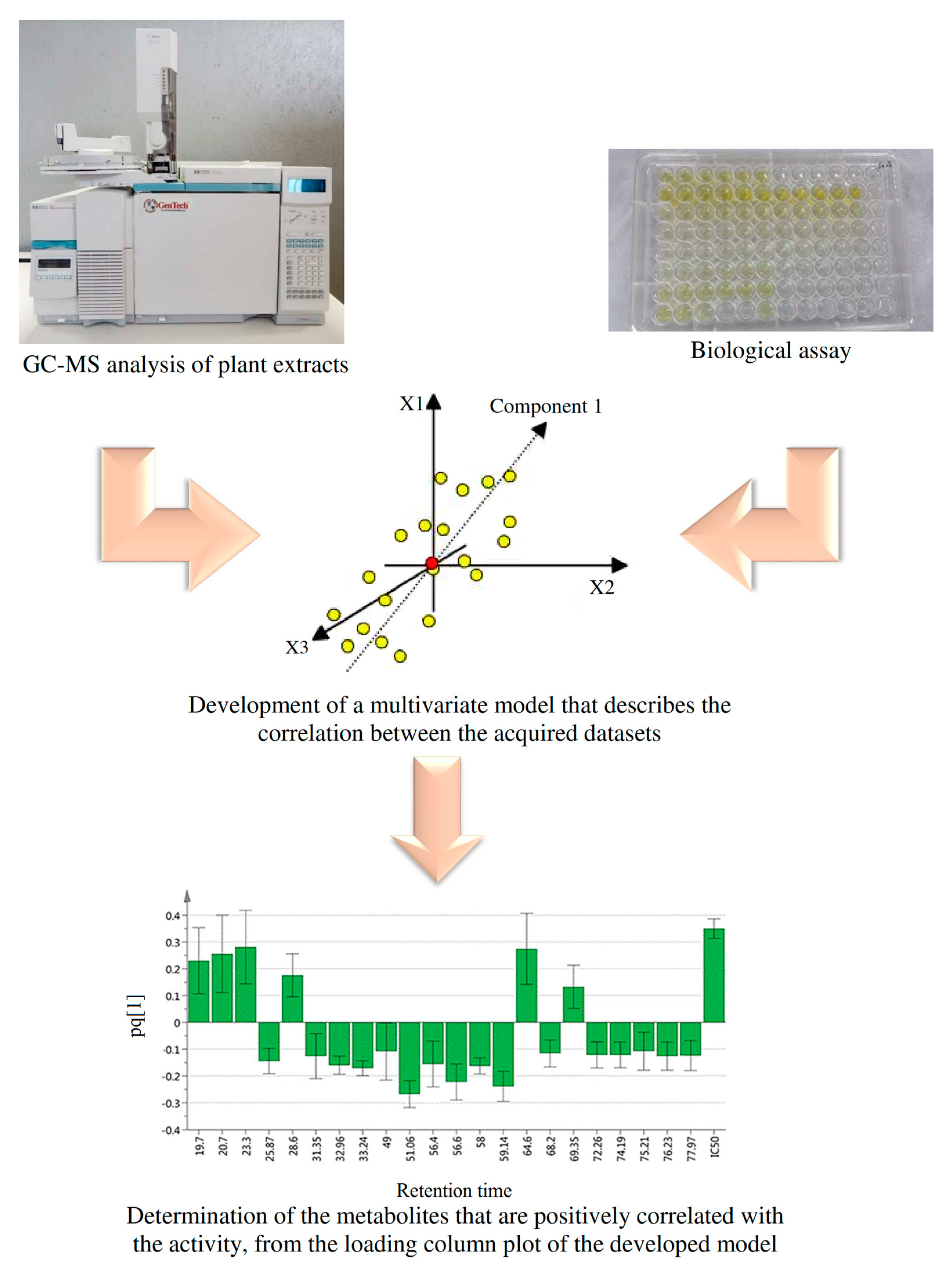
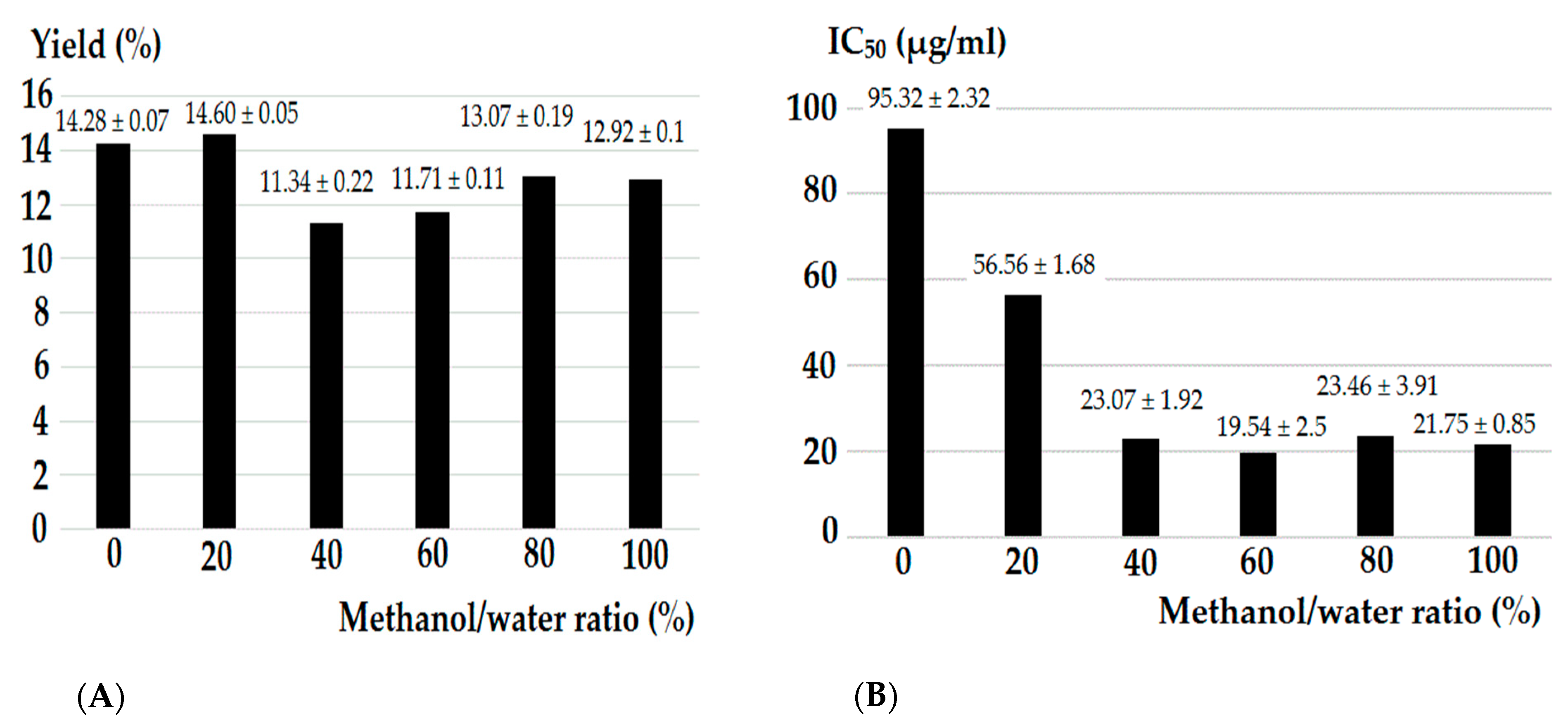

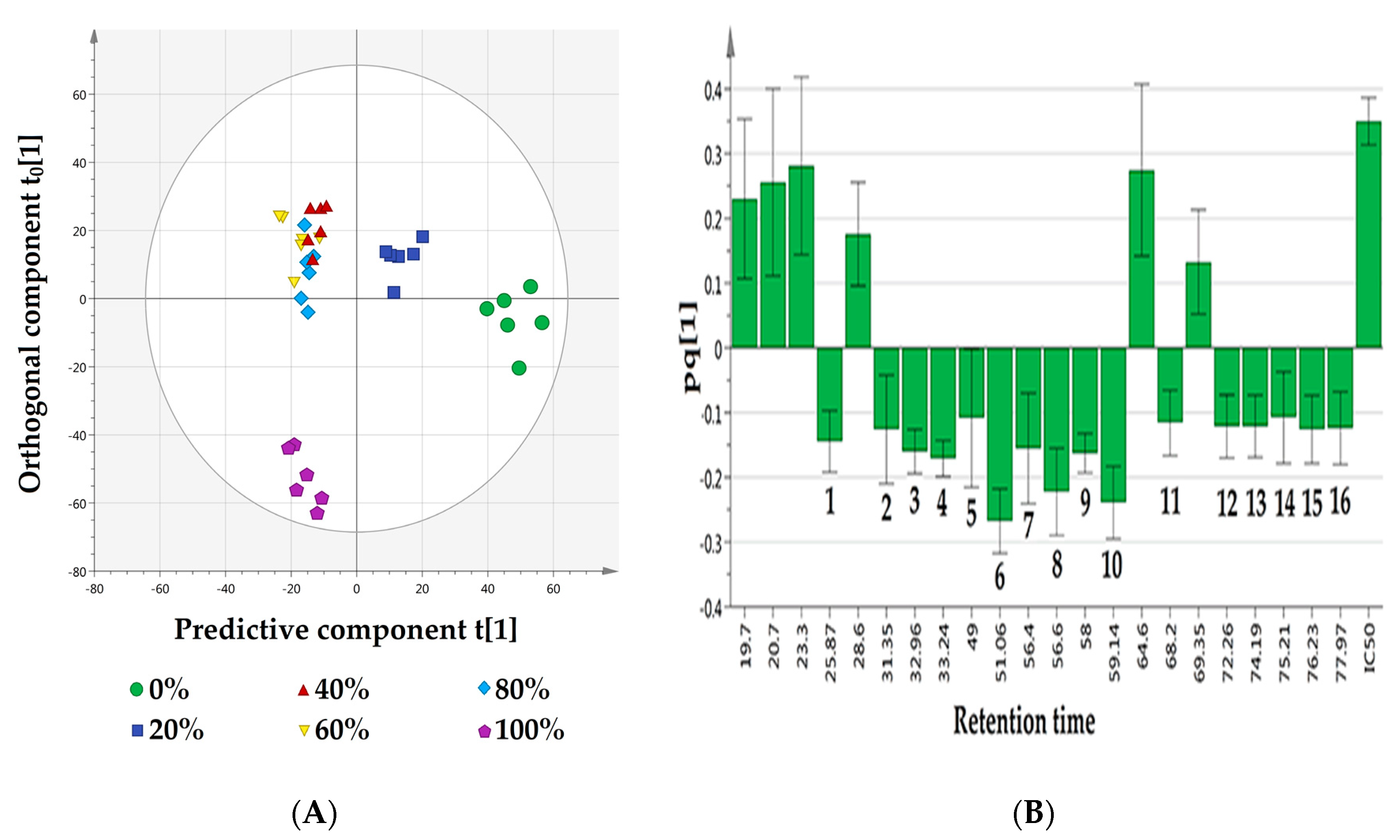
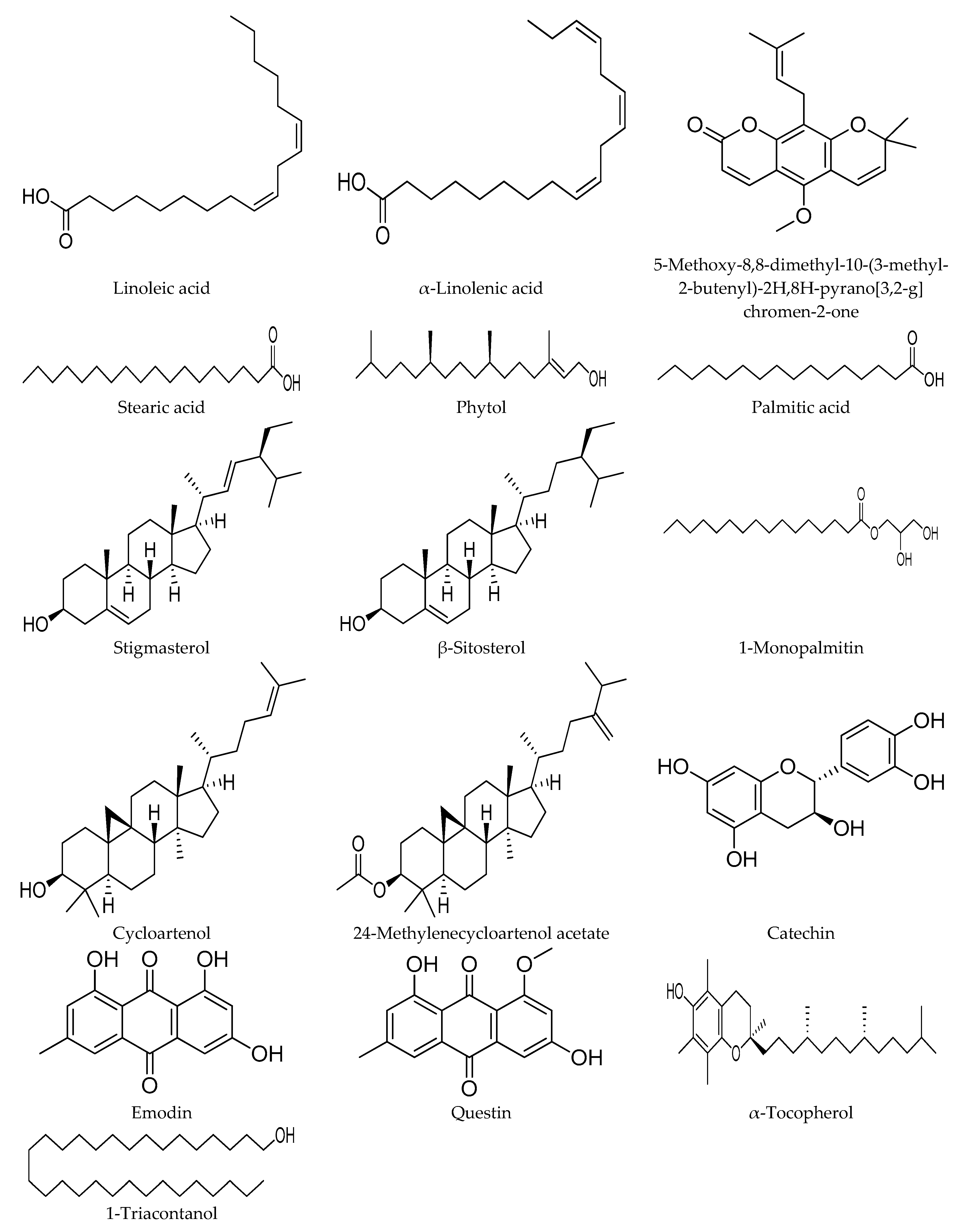
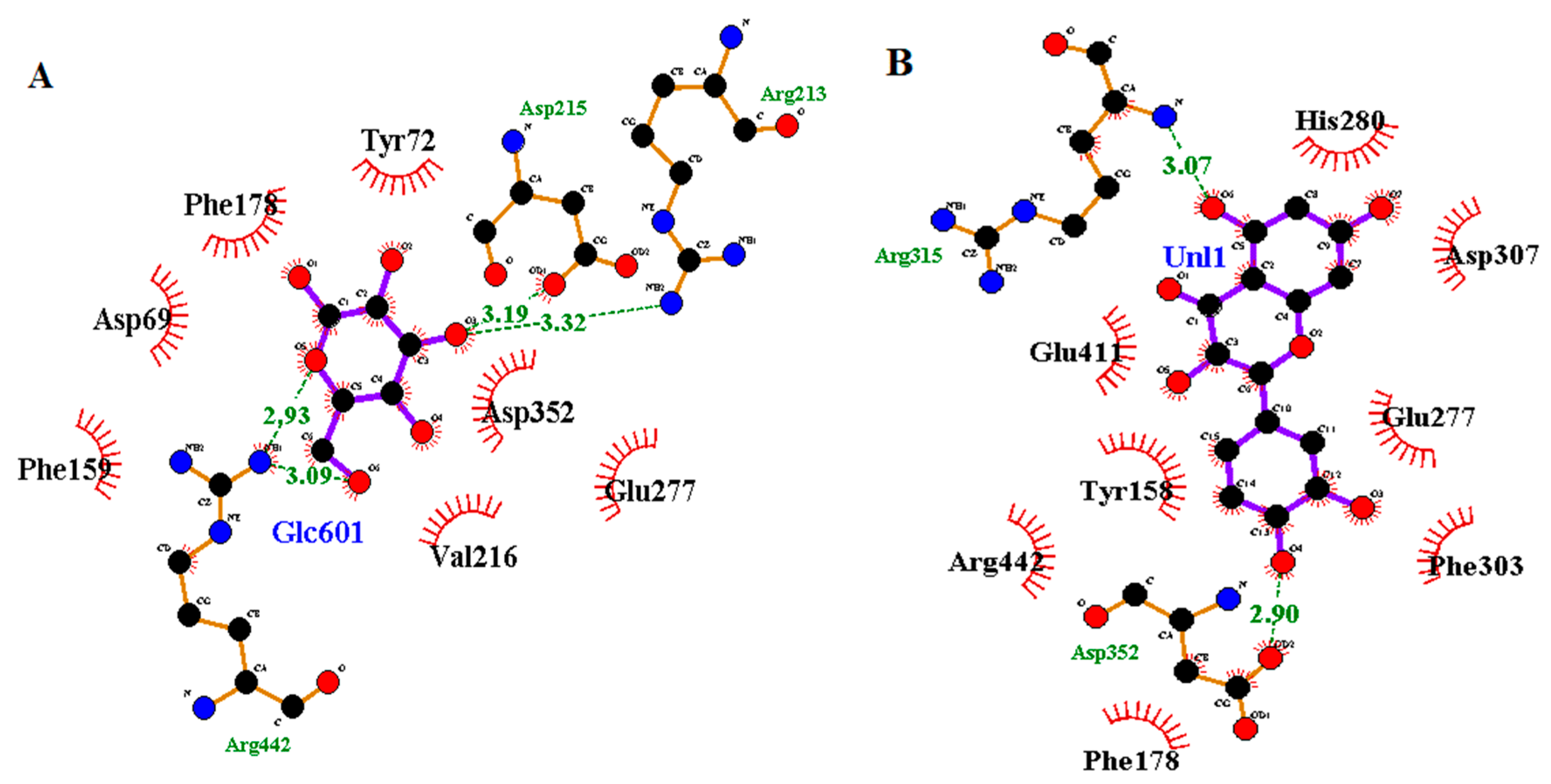
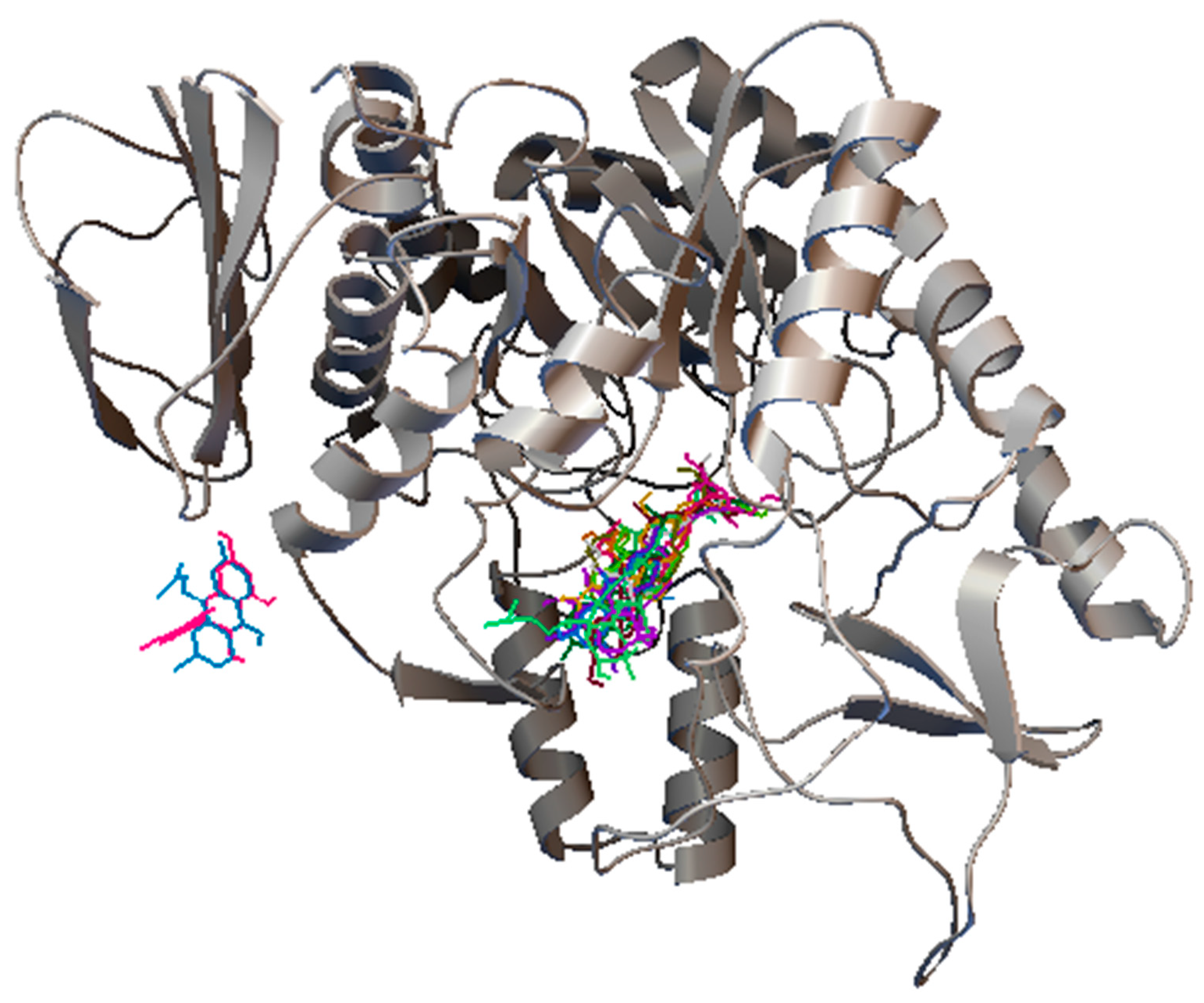
| No | RT (min) | Matching Index | Probability% | Molecular Weight | Molecular Formula | Putative Metabolite |
|---|---|---|---|---|---|---|
| 1 | 25.87 | 94.3 | 98.4 | 256.43 | C16H32O2 | Palmitic acid |
| 2 | 31.35 | 87.5 | 92.9 | 296.53 | C20H40O | Phytol |
| 3 | 32.96 | 76.6 | 92.7 | 280.45 | C18H32O2 | Linoleic acid |
| 4 | 33.24 | 73.9 | 59.6 | 278.43 | C18H30O2 | α-Linolenic acid |
| 5 | 49 | 90.5 | 94.6 | 330.5 | C19H38O4 | 1-Monopalmitin |
| 6 | 51.06 | 79 | 77.8 | 326.39 | C20H22O4 | 5-Methoxy-8,8-dimethyl-10-(3-methyl-2-butenyl)-2H,8H-pyrano[3,2-g] chromen-2-one |
| 7 | 56.4 | 88.1 | 86.8 | 284.48 | C18H36O2 | Stearic acid |
| 8 | 56.6 | 75.7 | 45.8 | 284.26 | C16H12O5 | Questin |
| 9 | 58 | 83.3 | 69.4 | 270.24 | C15H10O5 | Emodin |
| 10 | 59.14 | 81.4 | 76.4 | 290.27 | C15H14O6 | Catechin |
| 11 | 68.2 | 88.3 | 59.1 | 430.71 | C29H50O2 | α-Tocopherol |
| 12 | 72.26 | 76.1 | 69.8 | 412.7 | C29H48O | Stigmasterol |
| 13 | 74.19 | 93.7 | 97.7 | 414.71 | C29H50O | β-Sitosterol |
| 14 | 75.21 | 92.8 | 85.6 | 438.82 | C30H62O | 1-Triacontanol |
| 15 | 76.23 | 80.7 | 89.1 | 426.72 | C30H50O | Cycloartenol |
| 16 | 77.97 | 83.8 | 77.8 | 482.79 | C33H54O2 | 24-Methylenecycloartenol acetate |
| Docked Metabolite | Predicted Binding Energy (Kcal/mol) | Residues Involved in Hydrogen Bonding | Residues Involved in Hydrophobic Interactions |
|---|---|---|---|
| Maltose (control docking) | −6 | Arg213, Arg442, Asp215 | Tyr72, Phe178, Asp69, Phe159, Asp352, Glu277, Val216 |
| Quercetin (positive control) | −8.8 | Arg315, Asp352 | His280, Asp307, Glu277, Phe303, Phe178, Arg442, Tyr158, Glu411 |
| Palmitic acid | −6.1 | Gln353 | Arg315, Arg442, Phe303, Asp352, Glu411, Tyr158, Glu277, Tyr72, Phe178, Phe159, Val216, Asp215, Asp69, His351 |
| Phytol | −6.8 | Arg446, Asp352 | Arg315, Phe303, Gln353, Arg442, His351, Asp69, Asp215, Tyr72, Glu277, Val216, Phe178, Glu411, Gln279, Tyr158 |
| Linoleic acid | −6.4 | Asp215, His351 | Glu411, Val216, Phe178, Gln279, Phe303, Arg315, His280, Asp307, Gln353, Tyr158, Arg442, Asp352, Tyr72 |
| α-Linolenic acid | −6.5 | Arg213, Glu277 | Gln279, Phe59, Arg442, Glu411, Phe178, Tyr158, Val216, Asp215, Tyr72, Asp307, Asp352, Gln353, Phe303, Arg315 |
| 1-Monopalmitin | −5.9 | Gln182, His112, Asp69, Arg442, | Asp215, Tyr72, Phe178, Tyr158, Phe159, Glu411, Asp307, Arg315, Asp352, Phe303, Gln279 |
| 5-Methoxy-8,8-dimethyl-10-(3-methyl-2-butenyl)-2H,8H-pyrano[3,2-g] chromen-2-one | −8.2 | His 280 | Phe159, Glu411, Tyr158, Phe178, Arg442, Arg315, Phe303, Asp307 |
| Questin | −8.3 | Pro312, His280, Tyr158, Arg315 | Gln279, Glu277, Glu411, Leu313, Phe314, Phe303 |
| Emodin | −8.2 | Arg315, Pro312, His280, Glu411, Tyr158 | Gln279, Phe303, Phe314 |
| Catechin | −8.4 | Arg315 | His280, Asp307, Glu277, Phe303, Asp352, Arg442, Phe178, Tyr158, Glu411 |
| α-Tocopherol | −8.3 | Arg315, Asp307 | Ser311, Pro312, Asp242, Tyr158, Glu411, Arg442, Phe159, Phe178, Asp215, His112, Val216, Tyr72, Asp69, Gln279, Phe303 |
| Stigmasterol | −9.1 | Ser311, Pro312 | Asp215, Arg442, Asp69, Tyr72, His351, Val216, Gln182, Glu411, Phe178, Asp352, Glu277, His112, Tyr158, Gln279, Phe159, Arg315, Phe303, Leu313, Phe314, Asp307 |
| β-Sitosterol | −8.8 | Pro312 | Leu313, Phe314, Tyr158, Asp69, Asp352, Glu411, Arg442, Tyr72, His351, His112, Arg213, Asp215, Phe303, Phe178, Glu277, Gln279, Arg315 |
| Cycloartenol | −9.8 | Pro312 | Asp242, Ser240, Tyr158, Glu411, Glu277, Arg442, Asp215, Phe178, Asp352, Asp69, Arg315, Gln279, |
| 24-Methylenecycloartenol acetate | −8.8 | Arg442 | Asp352, Phe178, Glu411, Phe159, Gln279, His280, Thr310, Arg315, Asp307, Pro312, Phe303, Tyr158, Glu277 |
© 2020 by the authors. Licensee MDPI, Basel, Switzerland. This article is an open access article distributed under the terms and conditions of the Creative Commons Attribution (CC BY) license (http://creativecommons.org/licenses/by/4.0/).
Share and Cite
Nokhala, A.; Siddiqui, M.J.; Ahmed, Q.U.; Ahamad Bustamam, M.S.; Zakaria, Z.A. Investigation of α-Glucosidase Inhibitory Metabolites from Tetracera scandens Leaves by GC–MS Metabolite Profiling and Docking Studies. Biomolecules 2020, 10, 287. https://doi.org/10.3390/biom10020287
Nokhala A, Siddiqui MJ, Ahmed QU, Ahamad Bustamam MS, Zakaria ZA. Investigation of α-Glucosidase Inhibitory Metabolites from Tetracera scandens Leaves by GC–MS Metabolite Profiling and Docking Studies. Biomolecules. 2020; 10(2):287. https://doi.org/10.3390/biom10020287
Chicago/Turabian StyleNokhala, Ahmed, Mohammad Jamshed Siddiqui, Qamar Uddin Ahmed, Muhammad Safwan Ahamad Bustamam, and Zainul Amiruddin Zakaria. 2020. "Investigation of α-Glucosidase Inhibitory Metabolites from Tetracera scandens Leaves by GC–MS Metabolite Profiling and Docking Studies" Biomolecules 10, no. 2: 287. https://doi.org/10.3390/biom10020287
APA StyleNokhala, A., Siddiqui, M. J., Ahmed, Q. U., Ahamad Bustamam, M. S., & Zakaria, Z. A. (2020). Investigation of α-Glucosidase Inhibitory Metabolites from Tetracera scandens Leaves by GC–MS Metabolite Profiling and Docking Studies. Biomolecules, 10(2), 287. https://doi.org/10.3390/biom10020287






